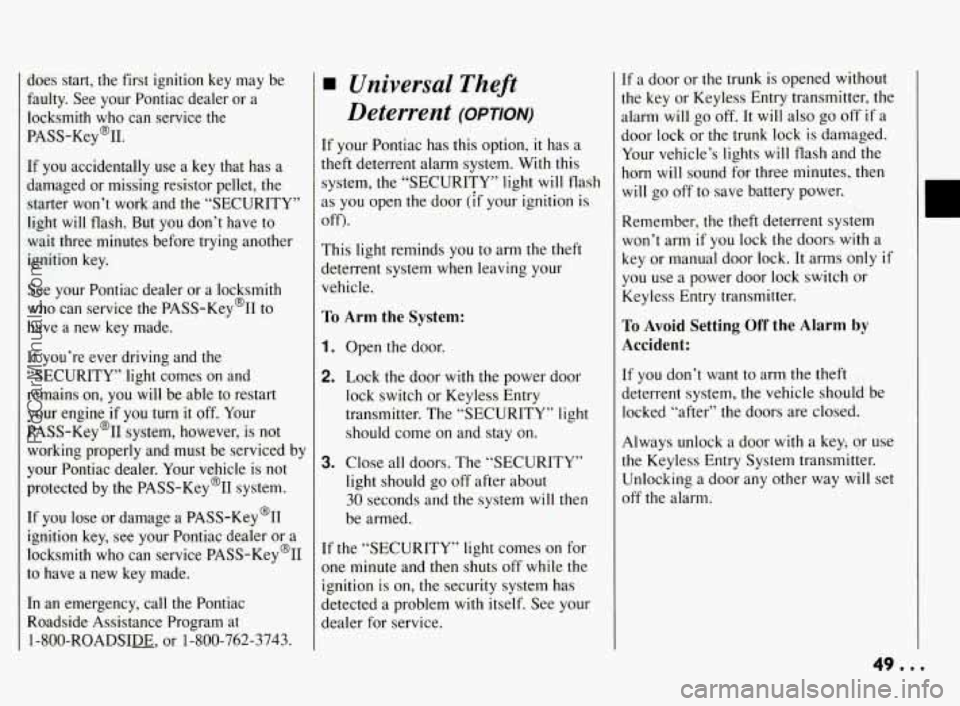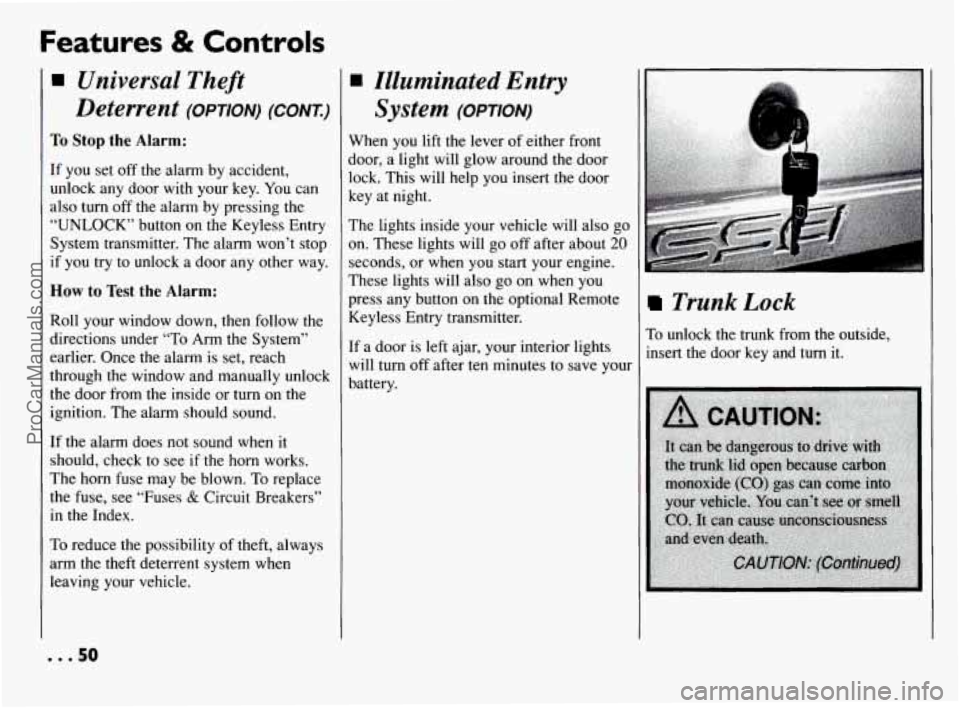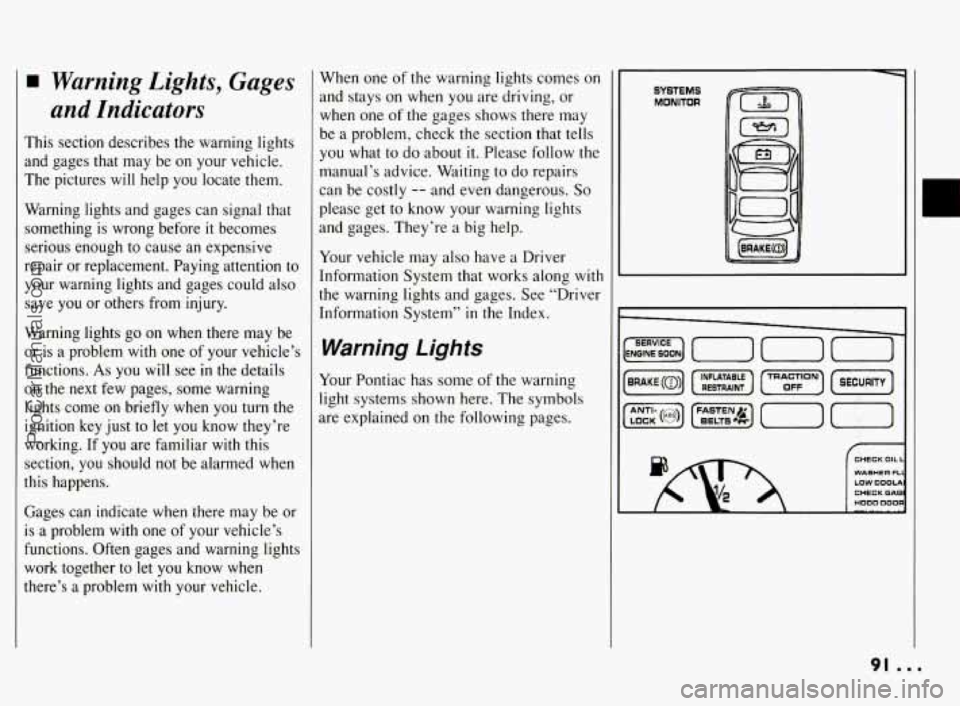Page 50 of 290

does start, the first ignition key may be
faulty. See your Pontiac dealer or a
locksmith who can service the
PASS-Key’II.
If you accidentally use
a key that has a
damaged
or missing resistor pellet, the
starter won’t work and the “SECURITY”
light
will flash. But you don’t have to
wait three minutes before trying another
ignition key.
See your Pontiac dealer or a locksmith
who can service the PASS-Key@II to
have
a new key made.
If you’re ever driving and the
“SECURITY” light comes on and
remains on, you
will be able to restart
your engine
if you turn it off. Your
PASS-Key@II system, however, is not working properly and must be serviced by
your Pontiac dealer. Your vehicle is not
protected by the PASS-Key@II system.
If you lose or damage
a PASS-Key@II
ignition key, see your Pontiac dealer or a
locksmith who can service PASS-Key@II
to have a new key made.
In an emergency, call the Pontiac
Roadside Assistance Program at
1-800-ROADSIDE, or
1-800-762-3743.
Universal Theft
Deterrent
-(OPTION)
If your Pontiac has this option, it has a
theft deterrent alarm system. With this
system, the “SECURITY”
light will flash
as you open the door
(if your ignition is
off).
This light reminds you to arm
the theft
deterrent system when leaving your
vehicle.
To Arm the System:
1. Open the door.
2. Lock the door with the power door
lock switch or Keyless Entry
transmitter. The “SECURITY” light
should come on and stay on.
3. Close all doors. The “SECURITY”
light should go off after about
30 seconds and the system will then
be armed.
If the “SECURITY” light comes on for
one
minute and then shuts off while the
ignition is on, the security system has
detected a problem with itself. See your
dealer for service.
If a door or the trunk is opened without
the key or Keyless Entry transmitter, the
alarm
will go off. It will also go off if a
door lock or the trunk lock is damaged.
Your vehicle’s lights
will flash and the
horn
will sound for three minutes, then
will go off to save battery power.
Remember, the theft deterrent system
won’t arm
if you lock the doors with a
key or manual door lock. It arms only if
you use a power door lock switch or
Keyless Entry transmitter.
To Avoid Setting Off the Alarm by
Accident:
If you don’t want to arm the theft
deterrent system, the vehicle should be
locked “after”
the doors are closed.
Always unlock
a door with a ke,y; or use
the Keyless Entry System transmitter.
Unlocking a door any other way will set
off the alarm.
ProCarManuals.com
Page 51 of 290

Features & Controls
Universal Theft
Deterrent
(omoN) (CONI)
To Stop the Alarm:
If you set off the alarm by accident,
unlock any door with your key.
You can
also
turn off the alarm by pressing the
“UNLOCK” button on the Keyless Entry
System transmitter. The alarm won’t stop
if you try to unlock a door any other way.
How to Test the Alarm:
Roll your window down, then follow the
directions under
“To Arm the System”
earlier. Once the alarm is set, reach
through the window and manually unlock
the door from the inside or
turn on the
ignition. The alarm should sound.
If the alarm does not sound when it
should, check to see
if the horn works.
The horn fuse may be blown. To replace
the fuse, see “Fuses
& Circuit Breakers”
in the Index.
To reduce the possibility
of theft, always
arm the theft deterrent system
when
leaving your vehicle.
H Illuminated Entry
System
(omoN)
When you lift the lever of either front
door, a light will glow around the door
lock. This will help you insert the door
key at night.
The lights inside your vehicle will also
go
on. These lights will go off after about 20
seconds, or when you start your engine.
These lights will also
go on when you
press any button on the optional Remote
Keyless Entry transmitter.
If a door is left ajar, your interior lights
will turn
off after ten minutes to save your
battery.
Trunk Lock
To unlock the trunk from the outside, insert the door key and
turn it.
... 50
ProCarManuals.com
Page 92 of 290

Warning Lights, Gages
and Indicators
This section describes the warning lights
and gages that may be on your vehicle.
The pictures will help you locate them.
Warning lights and gages can signal that
something is wrong before it becomes
serious enough to cause an expensive
repair or replacement. Paying attention to
your warning lights and gages could also
save you or others from injury.
Warning lights go on when there may be
or is a problem with one of your vehicle’s
functions.
As you will see in the details
on the next few pages, some warning
lights come on briefly when you turn the
ignition key just to let you know they’re
working. If you are familiar with this
section, you should not be alarmed when
this happens.
Gages can indicate when there may be or
is a problem with one of your vehicle’s
functions. Often gages and warning lights work together to let you know when
there’s a problem with your vehicle. When one of the warning lights
comes on
and stays on when
you are driving, or
when one of the gages shows there may
be a problem, check the section that tells
you what to do about it. Please follow the
manual’s advice. Waiting to do repairs
can be costly
-- and even dangerous. So
please get to know your warning lights
and gages. They’re a big help.
Your vehicle may also have a Driver
Information System that works along with
the warning lights and gages. See “Driver
Information System”
in the Index.
Warning Lights
Your Pontiac has some of the warning
light systems shown here. The symbols
are explained on the following pages.
SYSTEMS MONITOR
[-I [T) (-1
-g r-1 [-I I-]
7 CHECK OIL
WASHER FL
CHECKOAC LOW coau
91 ...
ProCarManuals.com